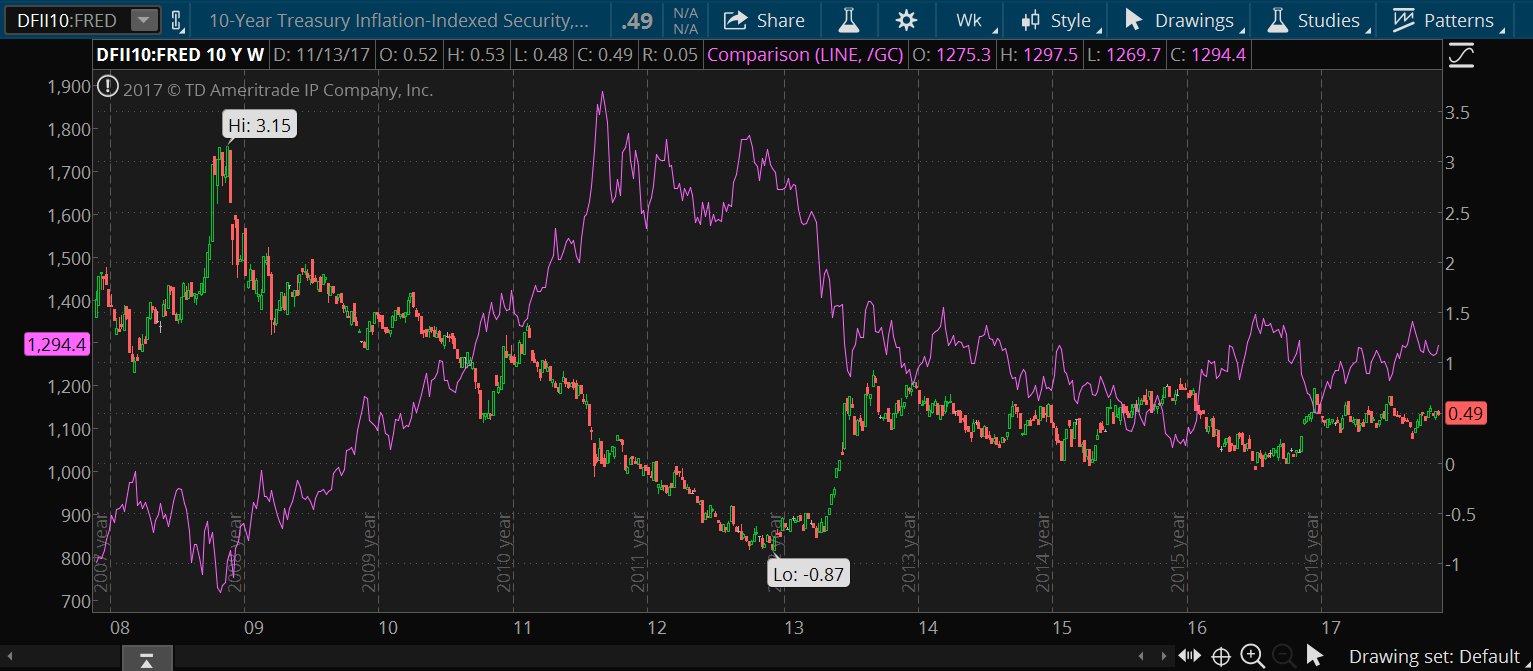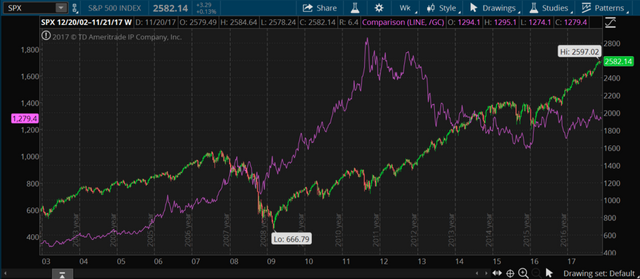How to Invest in Gold

Gold has served as a store of value for thousands of years. Contrast this with bitcoin, which has been storing value for only several years. Gold has a number of other practical applications besides being a store of value. It is used in wiring (gold conducts electricity without tarnishing or corroding), it is used to reflect solar radiation from spacecraft, in catalytic converters, in the production of chemicals, to fill cavities in teeth (gold fillings don't break like amalgam or composite fillings), and in an expanding list of other technological applications. Gold is also used in jewelry.
Many asset managers recommend a 5-10% portfolio allocation to gold, because in their opinion this helps diversify the portfolio. These asset managers maintain that gold is an uncorrelated asset that does well when stocks go down, and doesn't move with other assets. This is somewhat correct, but the reality is more complicated. We'll go over the main driver of gold below, as well as the supposed negative correlation with stocks that you'll see referenced in pieces about gold investing.
Let's first discuss some different ways to invest in gold through ETFs and stocks. I don't invest in physical gold, so I will not be discussing that type of investing. This post will be gold investing via paper assets galore, which I think most people find more convenient and realistic, not to mention more liquid, if getting your money out quickly is an important consideration for you.
I also will not be discussing gold futures, which I think are unsuitable for most investors, including myself. I’ve spend some time trading futures, and I can tell you that it is a great way to lose a lot of money very quickly. Futures also are not a set-it-and-forget-it strategy, because they expire and have to be rolled, and this presents additional costs both as far as fees, brain-power, and stress. If you need to replicate the stress of futures, don’t worry, I’ll recommend a couple of ways to trade the gold market that will help you lose sleep if that is your goal.
GLD
GLD is epic. Epic! GLD is SPDR Gold Shares, which is an ETF that gives investors access to the physical bullion market. By investing in GLD, you will get an undivided ownership interest in physical gold bullion. This is the purest gold play you can do without buying physical or entering the futures market. GLD does a great job of tracking the futures gold price, without the futures’ level of risk, hassle, and stress. What I love about GLD in addition to all this is that it doesn’t suffer from the horrific decay and tracking errors that are present in so many ETFs these days. And the expense ratio is a very reasonable 0.40%.
GLD is a relatively low volatility way of playing gold. So you can dollar-cost-average and also sleep at night. The price swings are in line with the swings of the gold futures, and the moves aren’t multiplied the way they are if you take a position in gold mining stocks, which are my preferred way of investing, and which we’ll discuss next.
Miners
I tend to go the way of gold mining stocks because I like the leveraged play on gold that these stocks provide. A couple of ETFs in this sector are GDX (larger mining companies) and GDXJ (junior mining companies). Disclosure: I have positions in both of these ETFs! These ETFs hold mining stocks that fit within certain criteria. Each ETF has an expense ratio just north of half a percent.
GDX has a good bit of leverage to the gold price, and GDXJ has even more, so when gold goes up, these go up big, and when gold goes down, these go down big. The tracking isn’t always perfect, so the mining shares may disconnect from gold now and again. Sometimes the miners lead gold, other times they lag, and a good number of gold market analysts like to read into these phenomena, but I think they’re mostly meaningless. Over the long-term, the miners follow the gold price.
Why do gold mining stocks experience outsized moves compared to gold? It’s because when the gold price goes up by, let’s say, 10%, that increase in the gold price could represent a doubling or tripling of a mining stock’s profits, depending on the miner’s all-in costs. For example, if gold is trading at $1,000, and a miner’s all-in costs are $950, if gold goes up 10% to $1,100, the miner’s profits have tripled from $50 to $150.
Note that there can be a lot of volatility in the miners. So if you're not into crazy price spikes and declines, stay with the much calmer GLD. And don’t touch the 2x or 3x leveraged gold ETFs. Just stay away. Yes, you can get significant outperformance in a strongly trending market, but sideways action decays the crap out of these ETFs. So be prepared to lose everything if you’re getting into NUGT or DUST type of plays. And, be sure to pull up the long-term chart and have a look at how these ETFs in some cases have lost 99% of their value since inception!
Some investors prefer to get into the individual stock plays in this sector. Examining the holdings of GDX and GDXJ is a good starting point for your research if this is your strategy.
Gold Price Drivers
What drives the price of gold? There actually is one main driver, and that is the real yield on the 10-year treasury. Super boring, right? Yeah, that’s why hardly anyone talks about it. But the real (inflation-adjusted) yield of the 10-year treasury bond drives the gold price because this yield offers a precise reflection of the market’s interest rate expectations, and gold spends most of its time trading as a bond substitute.
Are you asleep yet? Good. Because that is pretty much the holy grail of gold investing. I thought about bolding that last sentence about gold trading as a bond substitute, but then I thought, why make it too easy?
Gold usually trades inversely to the 10-year treasury yield. Look (gold is the purple line):


Super cool, right?
Yes, gold can also serve as a safe haven or flight-to-quality, but it basically is a bond with no yield and no (less) sovereign risk. Bonds have sovereign risk because there’s always some possibility, however small, that the issuing government fails to honor its bond payments and repayments. Gold is less dependent on the whim of governments, maybe. If you have physical gold, you probably have the least sovereign risk, but it’s probably not necessary to analyze sovereign risk with respect to gold and gold paper assets because if the government is making moves to confiscate gold, or the markets have stopped working, you have bigger problems. This tangent is now being moved to the comments.
Basically, as the yield on bonds rises, gold is worth relatively less. It’s a store of value like a bond, but as yields rise, it’s not worth as much because it doesn’t have a yield. When, on the other hand, yields go down, then real yields eventually become negative when yields sink low enough, and then gold offers a better bet than bonds, at least historically.
You can see how this played out after the Federal Reserve lowered interest rates to zero after the housing crisis. Gold went on a tear and peaked at its all-time-high in 2011. Then, expecting the end of low interest rate policy, gold went sideways and then entered a downtrend, which didn’t snap until the Federal Reserve started hiking rates. Why did gold stop going down when the Fed hiked rates? Because gold traders began to anticipate a lower terminal rate, and a portion of the rate hike cycle resumption was already priced in. Another super boring and extremely important point!
Where are we now? There’s probably more sideways and perhaps down action as the Federal Reserve continues to hike rates and has just begun quantitative tightening, both of which raise interest rates.
However, I think enough of the rate rise has been priced in to begin accumulating gold and gold miners in anticipation of the end of the rate hiking cycle, and the resumption of low rate policy and quantitative easing when we find ourselves in recession, which likely is not far off given how mature the business cycle is. I have accumulated quite a bit of miners via GDX and GDXJ for a multi-year play. Note again that gold began to recover from its downtrend when the Federal Reserve hiked rates for the first time in December 2015. Hmmm... Forward-looking markets are fascinating.
Correlation with Stocks
Gold’s most significant correlation is with real rates, as we’ve discussed, but we often hear that gold has an inverse relationship with stocks. Is this true?
There’s some inverse correlation, to be sure, but I would argue that it is actually the same correlation described above. When stocks dump and gold goes up, it is because traders are expecting lower interest rates for longer, because the Federal Reserve is less likely to hike when stocks go down.
Gold’s correlation with stocks can also be positive, for example during credit-crunch (deleveraging) scenarios when people are hit by a stock crash and need to liquidate various assets to pay their bills, and gold is hit just by virtue of being a liquid asset that can be converted into cash that can be converted into food and water and rent. However, soon after a crash, gold tends to have significant up moves, not necessarily because it is a safe haven, but because low interest rate policy is initiated to stimulate the recovery, and this low interest rate policy drives bond investors out of their negative real yielding favorite asset and into the next best (and at that time better) thing, and that thing is the shiny yellow metal that can hold value just as reliably as U.S. bonds, but which will not suffer the additional inflation hit.
Here are a couple of shots of the S&P versus gold (gold is the purple line again):


I hope you’ve found this to be useful. I remember when I was first studying gold and its relationship to interest rates and to other assets, I was frequently frustrated by the lack of information on this topic. Let me know about your experiences investing in gold in the comments!
You can find more of my posts at http://mooseworth.com. Thanks for reading and take care!
Disclaimer: All data and information provided in this post is for informational purposes only. It should not be considered legal or financial advice. You should consult with an attorney, financial advisor, or other professional to determine what may be best for your individual needs. I am not an investment advisor and I do not provide investment advice.